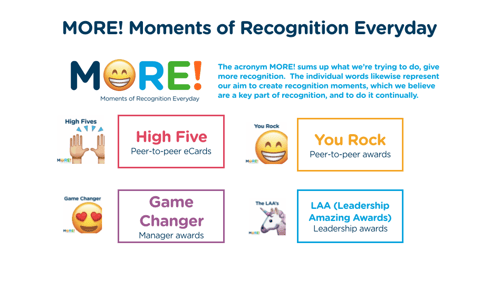Over the years there have been many definitions and theories on the differences between reward and recognition. In fact, there is one theory stating as many as 10 differences between the two. But instead of making things overly complicated, I thought I’d put an easier spin on things and present to you my own pared-down list to truly take a look at the difference between reward and recognition. Let’s begin:
First difference between reward and recognition: The "Why"
In the list of 10, it says that rewards are expected and recognition is not. To me, this is the biggest difference between reward and recognition, and I’d call it the “expectation difference.” When you receive a reward, you are not surprised as it’s something you expected as a result of achieving a specific target or outcome.
Learn more about our reward and recognition solutions »
But when employees receive employee recognition, it comes as a surprise as you (or your employees) have no expectation of receiving anything in return for the action or behaviour.
Another point I’ve heard before says that rewards are outcome-driven and recognition is behaviour-driven. I’m not sure I completely agree with this one, and although I do agree that rewards are linked to outcomes, recognition can and should be linked to both behaviours and outcomes, which is why I believe that the key to successful employee recognition programs is a values-based employee recognition program. An example is an eCard I sent to a colleague recognising them for their help in dropping everything to help write a case study. Was this a behaviour or was this an outcome, or was it both? Here are a few other eCard examples I love on recognising through values:
.png?width=500&name=mediamodifier_image%20(22).png)
The key to the “why” is to design reward programs that clearly identify the “why,” whether it is for an outcome, behaviour or both. For rewards it should clearly be shared at the front and at the end, and for recognition it should clearly be shared at the end.
Download our step-by-step guide to understanding employee rewards vs. employee recognition »
Next, the "When"
Here’s a familiar one: rewards are conditional and recognition is unconditional. I’ve also heard that rewards are transactional and recognition is relational. I agree with both of these statements because they talk about what I’d call the “consequence difference.”
Think of it this way: When it comes to rewards if you do “x, ”you receive “y.” It’s very black and white– there is a conditional consequence and relationship between your actions and the outcome. For recognition, however, there is no set conditions or consequences of your actions. In some situations you may be recognised with a simple thank you, in another situation you may be recognised with being taken out to lunch, etc.
The key to the “when” is to design programs, whether reward or recognition, that deliver the when as close to the event as possible. When I speak on this topic I often joke and say that if my husband only told me he loved me once every three years I’d leave him.
The point I’m making is that we cannot and should not wait to reward and recognise our employees if we want them to be engaged and stay with our companies.
Just like the message for Sydney Trains is, “mind the gap,” we too need to mind the gap between when an action or behaviour occurs and when we reward and recognise employees.
.jpg?width=500&name=Louis%20Kwakye%20-%20Nnamdi%20Anyanwu-6333%20(1).jpg) Thirdly, differences in the “who”
Thirdly, differences in the “who”
Another one to add to the list: rewards are fixed and recognition is free-flowing. I agree with this and would call it a “generational difference.” By the way, I’m not talking about differences based on the age of the employee, but differences based on who is generating or sending it. Rewards are generally given by a manager or the company, whereas with recognition, it can and should be given by anyone in the company – from a manager to a peer or continuous points of peer-to-peer employee recognition, too.
One thing I don’t agree with is the notion that rewards are impersonal and recognition is personal, at least not completely. I do agree that recognition is personal and that there is a very human element to both recognising others and being recognised. For rewards, I believe in the past it was very inhuman, such as a letter being sent at the end of the year to let you know the amount of your annual bonus.
But more and more companies are bringing the human element into reward, talking about and celebrating rewards, so I believe this is changing and should continue to change.
The key to the “who” is to create a balance of who is sending reward and recognition. If it is only done through managers, you’re missing a key element of the overall reward and recognition package, for it’s important to include not only reward and recognition, but also have it be accessible for all levels, peer-to-peer, manager-to-peer and so on. Allowing for greater access across all levels of an organisation can help make both reward and recognition have the personal and human touch – taking away the transactional nature so often done in the past.

Lastly, differences in the “what.”
Recognition programs have changed over the years, moving from long-service awards to more fully functioning recognition programs, and so the lines between labelling them as intangibles versus tangibles have gotten more blurred. Yes, rewards are tangible and consumed, but recognition can also be tangible and consumed.
The key to the “what’ is to create a balance of what is given through your programs, especially your reward and recognition programs. I believe that the majority of recognition awards should not be non-financial, as a thank you is the most powerful way to recognise humans, but there is also a time and place for tangible recognition awards. For example, in my company’s recognition program, MORE!, we have four plans, one are non-financial eCards, another is financial peer-to-peer awards, another is manager peer-to-peer awards, and the final one is an experiential award given from the leadership team, so a nice balance and variety in employee recognition of the "what."
All-in-all, these four differences between reward and recognition make them a perfect match for engaging your workforce. When each are used for the right reasons, from the appropriate person or team, and at the right time, employees will understand why they’re being rewarded or recognised and continue to repeat that behavior or task. I hope you can walk away from this post feeling confident about the differences between reward and recognition and feel empowered to impact engagement at your organisation.
 Debra Corey
Debra Corey
